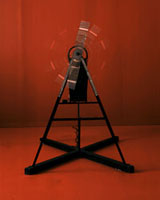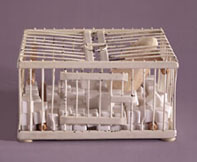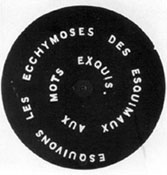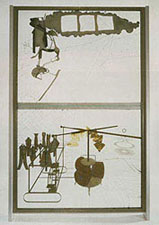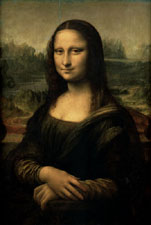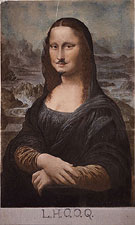click to enlarge
Figure 1
Marcel
Duchamp,Fresh Widow, 1920
In 1920 Marcel Duchamp duplicated choosing feminine features: those of Rose Sélavy. With this name indicates the copyright of Fresh Widow (Fig. 1), ready made resulting from the crafted assembly of a green window with French-style black leather panels. Those panels, for Duchamp’s insistence, had to be polished every day; and perhaps for this reason, for the newspaper and lewd rubbing of the skin, the French Window became, in the transformation of Duchamp, a Fresh Widow, namely a widow immodest.
Since that time the works of Rose multiply. His name is linked, again in 1920, the motor optical apparatus said Rotative plaques verre (optique de précision) (Fig. 2). The readymade of 1921 consists of a cage with cubes of marble and cuttlefish bone is christened Why not sneeze Rose Sélavy? (Fig. 3). woman sensual phrases are written in white letters spirals out of nine blacks discs in the short film Anemic Cinema (Fig. 4) shot by Man Ray and screened August 30, 1926 in a movie theater in Paris: while running, discs create buttons and sensations Sex. In September 1934 she also launches its editions with a book of perfect-as Dadaist late-expression: a box called La Mariée mise à nu par ses célibataires, même (Fig. 5) containing facsimile notes and reproductions, better known as the Boîte verte. But still: in April 1939 went to Paris in 515 copies of a booklet written by Marcel Duchamp entitled Rrose Sélavy, collection of “poils et coups de pied en tous genres”.
Meanwhile the name of Rose had become Rrose. The event of 1921: a word game published on page 6 of “The Pilhaou-Thibaou” (fifteenth issue of the magazine “391”) is signed Rrose Sélavy. Picabia had taken the phrase from a letter that Duchamp had sent him from New York in January. It was the first time in the floral name was added “r” and this did nothing to duplicate the character newborn. It was just the simple addition of a consonant to delineate better the mystery of the double: a newborn creature immediately began to transform itself, to own their own “biography.”
There is also Rrose photographic documentation. In 1921 Man Ray worked the single issue of the magazine “New York Dada” by publishing a photograph he had taken to Duchamp in women’s clothes Rrose Sélavy: a hat with patterned band and an elegant fox collar supported by the hands that palpate the heat. The photograph shows a facial expression elusive: atteggiate lips into a smile mysterious, subtle indifference eyes. The attractive hat had been lent to Marcel-Rrose by Germaine Everling, the Picabia companion: the anti-romantic Duchamp had chosen as the most visible sign of its transformation a headdress that belonged to a woman whose name-Germaine-alluded to the red-hot core romantic illusion: Germanism. The indifferent smile Rrose reminiscent of the Mona Lisa (Fig. 6): in ready made l.h.o.o.q. (Fig. 7) of 1919 Duchamp had already deformed the Gioconda by drawing in pencil a few thin mustache on a reproduction of the famous painting by Leonardo. (1)
What Rrose represents it can be clarified thanks to the dedication that appear in the image and reveals the identity: “Lovingly, Rrose Sélavy aka Marcel Duchamp.” It was therefore another me, to be added to the existing one with nothing to hide. However Rrose aspired to a legal personality and quickly armed himself with a business card:
Precision optics Rose Sélavy New York – Paris Complete assortment of mustaches and tricks
mustache and tricks
It does not need to know that (etc.)
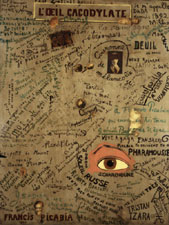
Figure 8
Francis Picabia,
L’Oeil cacodylate,
1921
It does not need to know that nell’emporio Marcel-Rrose you sell at will mustache to understand that the pseudonym pointed phonetically in an erotic direction: Rrose Sélavy sounds in fact like “Eros c’est la vie” ( “Eros: such is life” ). But not only that it was. In an interview with Pierre Cabanne, Duchamp expressed some illuminating remarks: “I wanted to change my identity and at first I had the idea to take a Hebrew name. I was a Catholic and this step of religion already meant a change. But I found no Hebrew name that I liked, or it hit my imagination, and suddenly I had an idea: why not change sex? From here comes the name of Rrose Sélavy. Today it sounds good enough, because even the names change over time, but in 1920 it was a silly name. The Double “R” has to do with the picture of Picabia Oeil Cacodylate (Fig. 8), exposed in the cabaret “Le Boeuf sur le Toit” -not know if it was sold-and Picabia asked all the friends to sign . I do not remember what I wrote, but the picture was photographed and therefore anyone knows. I think I wrote “Pi Qu’habilla Rrose Sélavy” ». The phrase that Duchamp wrote on Picabia framework sounds phonetically as “Picabia the arrose c’est la vie.” And it broadens the meaning to “Eros c’est la vie” to the phrase “arroser la vie,” meaning “have a drink over, make a toast to life.” (2)
Both meanings of the name refer to the vision of life nourished by Duchamp: if a first superficial consideration the transformation of Duchamp in Rrose Sélavy seems to trigger a lively game of interpretation, more accurate observation shows that coagulates transformation instead lasting erotics : one arising from the joy to live and roam free in thought. In fact, in addition to signing some ready made, Rrose writes of bon-mots, of puns intentionally senseless, but that at times sound highly explicit.
Rrose thus possesses a “language” personality born of a precise idea of language. In an interview published in “L’Express” of July 23, 1964, Duchamp said, “Language is a human error. Between two beings who love the word it does not express how much deeper they feel. The word is a pebble worn that applies to thirty-six shades of emotions. The language is easy to simplify it is a means of locomotion that I detest. ” “And yet-he says the interviewer-under the pseudonym Rrose Sélavy, she is interested in the language.” “It was for the fun. I have great respect for humor, it is a kind of protection that allows you to go through all the mirrors. ” ( 3)
click to enlarge
Figure 9
Marcel Duchamp, Young
Man and Girl in Spring,
1911
What is accomplished reading of those Rrose? Simply the joy of reading something always new, an experience that might remind you to pick fruit in an eden. Duchamp had announced in 1911 with the painting Jeune homme et jeune fille dans le printemps (Fig. 9): a pagan joy scene when two naked young men freely capture fruit from a plant growing in a lush natural environment. The bottom line is that only women can make themselves understood without recourse to meaning, as happens in the aphorisms Rrose. In other words, only the woman is impregnable. As irony.
[2]
Duchamp pursues a primitive form of eros: this is evident from his idea of marriage, she understood as a dead end, as a tomb. The Dimanches caricature of 1909 is merciless in this regard: the double couple with newborn baby, is reduced on Sundays to the boring walk where is the man to push the wheelchair, while his wife, pregnant again, walking wearily side. On your choice of bachelor, attracted to women but rejected by marriage, Duchamp once said to Pierre Cabanne: “I realized from an early age that we should not weigh you down with too much weight, with too many jobs, with a wife, with children, a country house, a car; fortunately I was convinced right away. That’s why I could live with much greater ease, as a bachelor, what I would do if I had to deal with all the usual problems of life. ” Duchamp always defended this sense of freedom, and writing once to Arturo Schwarz on the meaning of marriage said: “I’ve carefully avoided until the age of 67 years. I married a woman who, because of his age, could not have children. ” Although in fact he had already married in 1927, remaining married for the paltry three-month period. Eros is for Duchamp a serious matter; It is what replaces the irony absent. In an interview on 8 December 1961 Alain Jouffroy he asked Duchamp if he believed that humor was essential to the creation of the artwork, and he answered, “absolutely. I care particularly because seriousness is very dangerous thing. To avoid it is necessary the intervention of humor. The only serious thing I could consider is eroticism. Now that’s serious. ”
(4)
This idea is the basis of Rrose Sélavy philosophy, author of the aphorism that converts the pathos into a pleasure and excitement of writing in a thought. At the bottom of his procedure is eroticism, because Eros comes from the continuous news situation: the thought becomes erotic when it manifests itself as a thought in constant training, and as such is apparent from Duchamp’s works in 1911 and 1912 Dulcinée; Jeune homme dans un train sad; Nu descendant un escalier. To aspire to the erotic novelties you have to use the language into its elementary components. The language is Rrose for that chocolate that Duchamp grinding in Broyeuse de chocolat (1914) to obtain a cocoa powder which, with the addition of humorous sugar, becomes a sweet powder usable in many mixtures, something not viable with solid chocolate.
click to enlarge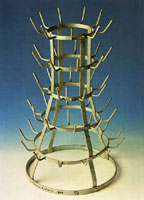
Figure 10
Marcel Duchamp, Bottle Dryer,
1914/1964
There is also a ready made of Duchamp that can be read in antiphrastic sense: Egouttoir 1914, the circular bottle rack (Fig. 10) standing without support, very common object in the wine France. It seems to represent what should not happen in the language: the aphorisms Rrose should not dry up like bottles stuck upside down in the bottle rack. Egouttoir obviously refers to the verb égoutter, drip, which in turn very closely recalls égoûter, remove taste: if something is drained loses all taste. The erotic procedure involves the preservation of taste: Sex is the difference, not the repetition. One of the strong points of Duchamp’s biography is the reason for its abandonment of painting: questioned about, always answered similarly. In the interview she appeared October 23, 1965 on the Spanish newspaper “Siglo XX” replied that it was “because of repetition: you can do three or four exceptional things, but everything else is repetition.” In the interview to “Paris-Normandie” of April 12, 1967 said that “there is nothing more boring than repetition. All that is not unusual or uncommon falls into oblivion. ” But the erotic also implies the need to escape the latch taste created by a static tradition. In the short film A conversation with Marcel Duchamp aired on NBC January 15, 1956, Marcel said at one point that there was a danger of reaching a kind of taste: “If you repeat a number of times, it becomes taste” . (5)
If there is a risk that Duchamp has systematically avoided it is to be repeated: tried constantly new ways of expression, up to the voluntary silence. Duchamp takes us by the hand and leads us to a luxurious vision of Nothing: despite this, his work triggers excitement. It happens to the body of the Jeune homme dans un train sad, and what the naked running down the stairs: both assume ever different form, such as ideas, to their liquid nature and eternally moving. Duchamp did not choose to portray firm forms, snapshots of a precise time, as well as the aphorisms Rrose are unrelated linguistic forms to common logic.
Duchamp eliminates any reference of authority: it does dissolving the meaning in a soft dough for free use. A man (the artist) makes the sign and let the other man (the user) should draw the meaning he wants. So there is the man, fleshy and round; there is the sign, geometric and creaky as the stylus that track; Finally there are the Meanings, Sea of Nothingness. With the sign you can create authority: you can create utopias and theologies. Meaning to assign a sign is how to establish a relationship of authority. But you can also rid the authority sign here is the erotic action, indifference task, the nullification of the way. If you remove the sign the Meaning, it appears purity. Duchamp came to free-movement with art-the Sign of the meanings, and to leave to sign the freedom to absorb the mixture of arbitrarily Meaning that the user specifies. And freedom is the Meaning of gesture art, gesture “political” in its very essence.
[3]
In the Dictionnaire du abrégé surréalisme Eluard and Breton they inserted the definition of Duchamp on ready made “normal Subject promoted to the rank of art object for the simple choice of the artist.” But Duchamp recurs elsewhere in the dictionary, and perhaps the initials M. D. initials that the “Hasard” are his “Hasard en conserve.” The definition means “The event preserves”; It may be deformed in “Jam of the case” and there you could find already a sense, certainly not wanted by Duchamp. You might think that the fact that the case is mixed very well with the rest of the case to form the jam every single existence. Preserve the case of Duchamp has he achieved by an act of pure caprice. In his work, he entices the viewer to interpret, to comment, to add to the data (if anything, the simple fact of the readymade) other data.
However, everything is arbitrary, useless, sterile ineffective. The production of Rrose (and Duchamp) causes an arcane stupor, refractory to any rational speculation. The erotic Rrose results in sterility of Gnostic flavor: there is in fact a form of sterile celibacy in those Rrose Sélavy. Are arbitrary sentences that trigger an idea, an image, a comment of reaction, a number of interpretations, in turn, sterile, unnecessarily repeated endlessly. And this refers to the great religious intuition of Giordano Bruno: the infinite universe that contrasts with the need for finite universe on which the Thomism was holding. Bruno, however, involves the field of divinity (pantheism), Duchamp, however, shows that matter is infinite Nothing. Bruno claims a gesture of consciousness: be aware that the infinite is the image of God present in every particle of the universe; Duchamp claim instead an act of irresponsibility: “The unconscious is an orphan, atheist, unmarried.” (6) Only through recklessness it is preserved celibacy and atheism. The single figure is an infidel, as the orphan’s abandonment figure of nowhere. In the religious sphere Duchamp cultivates a pure atheism, what leavens the case put canned.
But if the arbitrariness dominates the actions of Duchamp, his choice of infertility is free. He could choose to be fertile; choose instead of being sterile, and let the multiplication of nowhere is implemented by those who are fertile, ie the “other.” He bequeaths a castle that sterile multiply interpretations of his works of art or-in the case of Rrose-of his aphorisms. Thereby establishes a two-way relationship: the barren makes sure that the fertile may perpetuate his futile fertility; fertile grants the bachelor-sterile remain so: grant him the pleasure of onanism (bachelor’s onanist by definition).
It should not be considered of secondary importance that the business card Rrose the first title is the business of “Precision Optics” is a clear invitation to take, in trade with Rrose, a precise look that omit nothing, or at least do not put into the background some observations for which you need special perspective arm themselves.
It is gnostic optics.
Gnostic idea is that man is a lump of light lit in the dark prison of the world, full of pain and hurt. The world output is only possible with a purification, also punishable by transformation into a different creature. Rrose is an erotic and at the same time pure creature with his birth, like that of Botticelli’s Primavera by the waves, Duchamp landed at an unprecedented conquest of knowledge and vision. Its transformation into a female character was not a sacrifice in the name of the Great Mediterranean Mother, but the definition of pure being Gnostic (Cathar) as a creature who lives outside of the world.
Lover of all modern forms of expression, even Breton paused several times on the figure of Duchamp. In Testimony 45, article published in March 1945 in the special issue devoted to Duchamp by the American magazine “View”, Breton poses a radical question: to what extent, after the appearance of the major work of Duchamp, The Marié mise à nu, both legitimate to continue painting as if it did not exist. The appearance of Duchamp becomes second Breton something increasingly imperative: “It tends to denounce as obsolete and useless most of the recent artistic production.” (7)
Here is the purifying action of Duchamp, his evangelical Cathars: make a clean sweep of all, the need to impose the New Radically. He did it by becoming incarnate in Rrose Sélavy and making a Erotica Gnosis or, if you prefer, a Gnostic Erotica: in any case coming to the highest position to understand what in the world-and in life-worth is attempted.
Notes
 1. The androgyny of the Mona Lisa with a mustache is just the most visible aspect of a phenomenon that has much more profound developments. See the long article by Lanier Graham,
Duchamp & amp; Androgyny: The Concept and its Context
Tout-Fait. The Marcel Duchamp Studies Online Journal, vol. 2, n. 4, January 2002. & lt; http://www.toutfait.com/issues/volume2/issue_4/articles/graham/graham1.html
1. The androgyny of the Mona Lisa with a mustache is just the most visible aspect of a phenomenon that has much more profound developments. See the long article by Lanier Graham,
Duchamp & amp; Androgyny: The Concept and its Context
Tout-Fait. The Marcel Duchamp Studies Online Journal, vol. 2, n. 4, January 2002. & lt; http://www.toutfait.com/issues/volume2/issue_4/articles/graham/graham1.html
In this area could also fall sexual alteration of Étant donnés (the 1946-1966): the female genitalia observed through the holes of the door appear off-center, as if the artistic reality is different from that of nature . But back to Man Ray should be noted that he was the photographer of both the female nudity is of that priapo paperweight that exists in marble and metal versions. Photographing Rrose, Man Ray operated a blending of the feminine and priapic, up to portray a sexually ambiguous creature and infertile. If in fact the priapo fixed erection on a cold ineptitude so the eternally naked woman Man Ray does not raise physiological tension and the viewer turns into an icy inept.
 2. M. Duchamp, Ingénieur du temps perdu. Entretiens avec Pierre Cabanne , Paris, Belfond, 1967, p. 118. The exact phrase written on the painting by Picabia was “en 6 qu’habilla rrose Sélavy”; you can see a good reproduction of the picture in Arturo Shwarz, Almanac Dada , Cambridge: Polity Press, 1976, p. 340. But see also Jennifer Gough-Cooper and Jacques Caumont, “Ephemerides on and about Marcel Duchamp and Rrose Sélavy 1887-1968,” in volume Marcel Duchamp , Milan, Bompiani, 1993, the date of November 1, 1921.
2. M. Duchamp, Ingénieur du temps perdu. Entretiens avec Pierre Cabanne , Paris, Belfond, 1967, p. 118. The exact phrase written on the painting by Picabia was “en 6 qu’habilla rrose Sélavy”; you can see a good reproduction of the picture in Arturo Shwarz, Almanac Dada , Cambridge: Polity Press, 1976, p. 340. But see also Jennifer Gough-Cooper and Jacques Caumont, “Ephemerides on and about Marcel Duchamp and Rrose Sélavy 1887-1968,” in volume Marcel Duchamp , Milan, Bompiani, 1993, the date of November 1, 1921.
 3. The interview of 23 July 1964 published in the aforementioned Ephemeris , to date. The production aphoristic Rrose Sélavy is collected in Marcel Duchamp, Marchand du sel. Ecrits de Marcel Duchamp , edited by M. Sanouillet, Paris, Le Terrain Vague, 1958 (Italian translation: Cava dei Tirreni, Rumma Publisher, 1969) and in Duchamp du signe. Ecrits , edited by M. Sanouillet, Paris, Flammarion, 1994. Michel Sanouillet and Elmer Peterson have dedicated to these phrases a whole chapter of their book Salt Seller . The Writings of Marcel Duchamp , New York, Oxford University Press, 1973.
3. The interview of 23 July 1964 published in the aforementioned Ephemeris , to date. The production aphoristic Rrose Sélavy is collected in Marcel Duchamp, Marchand du sel. Ecrits de Marcel Duchamp , edited by M. Sanouillet, Paris, Le Terrain Vague, 1958 (Italian translation: Cava dei Tirreni, Rumma Publisher, 1969) and in Duchamp du signe. Ecrits , edited by M. Sanouillet, Paris, Flammarion, 1994. Michel Sanouillet and Elmer Peterson have dedicated to these phrases a whole chapter of their book Salt Seller . The Writings of Marcel Duchamp , New York, Oxford University Press, 1973.
 4. To see the interview of Cabanne. Ingénieur du temps perdu , cit., P. 23. The idea expressed in Schwarz is reported in
The machines celibate, curated by Harald Szeemann, Milan, Electa, 1989, p. 189 note 4. The interview of 8 December 1961 was published in the aforementioned Ephemeris , to date. The humor value it also reads the first lines of the interview released by Duchamp to Guy Viau of the Canadian Radio-Television July 17, 1960, now published under the title changer de nom, Simplement Tout-Fait. The Marcel Duchamp Studies Online Journal, vol. 2, n. 4, January 2002.lt;
http://www.toutfait.com/issues/volume2/issue_4/interviews/md_guy/md_guy.html
4. To see the interview of Cabanne. Ingénieur du temps perdu , cit., P. 23. The idea expressed in Schwarz is reported in
The machines celibate, curated by Harald Szeemann, Milan, Electa, 1989, p. 189 note 4. The interview of 8 December 1961 was published in the aforementioned Ephemeris , to date. The humor value it also reads the first lines of the interview released by Duchamp to Guy Viau of the Canadian Radio-Television July 17, 1960, now published under the title changer de nom, Simplement Tout-Fait. The Marcel Duchamp Studies Online Journal, vol. 2, n. 4, January 2002.lt;
http://www.toutfait.com/issues/volume2/issue_4/interviews/md_guy/md_guy.html
The erotic pursued by Duchamp seems to dive into the theory that Susan Sontag expresses the Against Interpretation ; the American writer there says that the vitality of interpretation is saved by the application of an “erotic” procedure, “hermeneutics.”
 5. For all these statements, see the aforementioned Ephemeris , the respective dates.
5. For all these statements, see the aforementioned Ephemeris , the respective dates.
 6. Gilles Deleuze, in The Bachelor Machines , cit., P. 15.
6. Gilles Deleuze, in The Bachelor Machines , cit., P. 15.
 7. The article is now collected in André Breton, Oeuvres completes , vol. III, Paris, Gallimard, 1999, pp. 144-145.
7. The article is now collected in André Breton, Oeuvres completes , vol. III, Paris, Gallimard, 1999, pp. 144-145.
Figs. 1-5, 7, 9-10 © 2003 Succession Marcel Duchamp, ARS, N.Y./ADAGP, Paris. All rights reserved.




